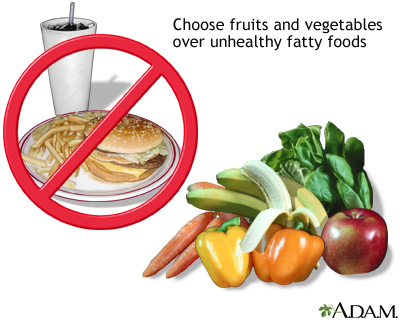| Step 5: Modify your diet |
Calories are the basic unit of energy within food. When you eat, your body converts calories into energy. Your body uses what it can and stores the rest in the form of fat. You should eat a low-calorie diet if you want to lose weight.
A calorie is a calorie, whether it comes from a brownie or a serving of raw broccoli. The difference between them is the number of calories, nutrients, fat, and other ingredients in a typical serving.

| Food | Serving size | Calories | Fat (grams) |
| Broccoli | 1/2 cup | 12 | 0.2 |
| Brownie | 1 square | 160 | 3 |
Calorie counting
Some diets involve calorie counting -- figuring out the number of calories in each food item you eat, then adding up the total at the end of the day. This method shows:
- How quickly calories add up
- Where most of your calories come from
- What time of day you tend to eat the largest amount
This can be valuable information, particularly when you first start your weight loss program. The method allows you to make adjustments to your food consumption on a particular day or over time.
Counting calories, however, quickly becomes tedious, and it does not necessarily train you to eat a healthy balance of foods. It is easy to become obsessed with the numbers and forget that the point is to eat healthily and vary your foods.
Eat less, or eat healthy?
Obviously, you can reduce calories simply by eating less. For example, if you usually eat French fries with lunch, order a smaller portion or throw some of them out. Although in theory this method should help you lose weight, it is not the healthiest or most successful.
First of all, you are not eating a balanced, nutritious diet, nor are you lowering your risk for chronic conditions like diabetes and heart disease. Furthermore, people who simply try to eat less, rather than changing food types, tend to get hungrier faster and snack more in between meals.
Instead, replace unhealthy and fattening foods with healthier alternatives -- eat the same amount of food as before but eat lower-calorie foods with a healthier balance of nutrients. Using the example above, you would replace the French fries with a baked potato, carrots, an apple, or another healthier and lower-calorie food. Again, you are eating fewer calories, but you are also filling your stomach and adding variety to your diet.

Hints for eating nutritious foods
- Choose fresh fruits and vegetables over canned or processed foods. Food often loses its natural vitamins and minerals during processing. Fresh food is also more flavorful, so you will feel more satisfied.
- Lower your fat intake by eating a plant-based diet. Animal products tend to be higher in saturated fat (and therefore calories) than most plant products.
- Choose products (like breads and pasta) with whole grains over those with white flour. These have more fiber, are more likely to fill you up, and are more nutritious. The fiber may even help lower your cholesterol.
- Allow yourself an occasional treat, so you don't feel deprived. It can be easier to change your habits if you know you can still have your favorite dessert or snack once in awhile.
- Eat fish instead of meat. Fish is a healthy, lean protein. Also, it contains a type of fat called "omega-3," which may help protect the heart.

Empty calories
Some foods are especially bad for weight loss. Foods that contain a high number of calories without providing important nutrients are referred to as "empty calories." Sugary snacks, soda, and alcohol, for example, can dramatically increase the number of calories you consume without providing any nutritional value. They should be consumed only in small quantities.
One step at a time
Changing eating patterns can be extremely difficult. Food plays so many roles in our lives, and we've formed our eating habits over many years. It may be easier to make one food substitution at a time -- for example, switch from whole milk to skim milk, then eliminate butter from your diet. Once again, gradual progress is the key to successful weight loss and maintenance.
Since most Americans eat too much fat and sugar (both of which contribute to weight gain), replacing these with whole grains, fruits, and vegetables should lower your intake of calories and provide rich sources of vitamins and minerals at the same time. Also, protein should come from low-fat sources like fish, beans, chicken, and soy.
 |
|
|
Review Date:
6/28/2011 Reviewed By: Patrika Tsai, M.D., M.P.H., Assistant Clinical Professor, Pediatric Gastroenterology, Hepatology and Nutrition, University of California, San Francisco, San Francisco, CA. Review provided by VeriMed Healthcare Network. |
